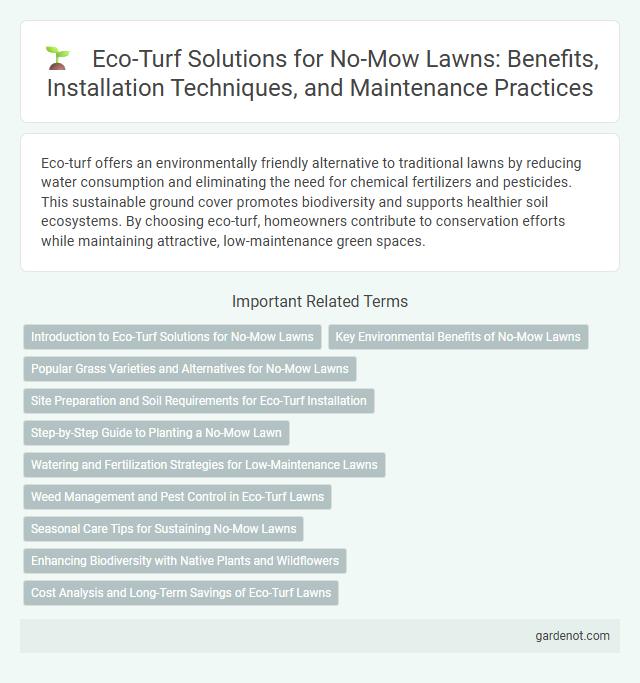Eco-turf offers an environmentally friendly alternative to traditional lawns by reducing water consumption and eliminating the need for chemical fertilizers and pesticides. This sustainable ground cover promotes biodiversity and supports healthier soil ecosystems. By choosing eco-turf, homeowners contribute to conservation efforts while maintaining attractive, low-maintenance green spaces.
Introduction to Eco-Turf Solutions for No-Mow Lawns
Eco-Turf offers innovative no-mow lawn solutions designed to reduce maintenance while enhancing environmental sustainability. Utilizing drought-resistant, low-growing grass varieties, Eco-Turf minimizes water usage and eliminates the need for regular mowing equipment, reducing carbon emissions. These eco-friendly turf options provide durable, attractive ground cover that supports local biodiversity and promotes soil health.
Key Environmental Benefits of No-Mow Lawns
Eco-turf no-mow lawns significantly reduce water consumption by thriving on natural rainfall, minimizing irrigation needs. These lawns enhance biodiversity by providing habitats for pollinators and beneficial insects, contributing to healthier ecosystems. They also improve soil health through reduced compaction and increased organic matter, promoting sustainable land management.
Popular Grass Varieties and Alternatives for No-Mow Lawns
Eco-turf for no-mow lawns often includes popular grass varieties such as fine fescues, buffalo grass, and zoysia, known for their low maintenance and drought tolerance. Alternatives like clover and native wildflowers contribute to biodiversity while requiring minimal mowing and water. These options create sustainable, eco-friendly lawns that reduce lawn care efforts and environmental impact.
Site Preparation and Soil Requirements for Eco-Turf Installation
Site preparation for Eco-Turf installation requires thorough soil assessment to ensure optimal drainage and nutrient balance, promoting healthy root development. Proper soil aeration and amendment with organic matter enhance Eco-Turf establishment and long-term sustainability. Maintaining a pH level between 6.0 and 7.0 supports nutrient uptake, critical for Eco-Turf thriving in no-mow lawn applications.
Step-by-Step Guide to Planting a No-Mow Lawn
Eco-Turf offers a sustainable no-mow lawn solution by using drought-resistant native grasses that require minimal maintenance. Begin by preparing soil with proper aeration and removing existing grass to ensure optimal root growth for Eco-Turf blends. After evenly spreading Eco-Turf seeds, apply a thin layer of mulch and water consistently until establishment, reducing water usage and eliminating the need for mowing.
Watering and Fertilization Strategies for Low-Maintenance Lawns
Eco-turf requires minimal watering due to its drought-resistant grass varieties, promoting water conservation and reducing irrigation costs. Fertilization strategies focus on slow-release, organic nutrients that support soil health and reduce chemical runoff. Adopting these practices ensures a sustainable, low-maintenance lawn with enhanced resilience and environmental benefits.
Weed Management and Pest Control in Eco-Turf Lawns
Eco-turf lawns naturally suppress weeds through dense, resilient grass varieties that minimize bare patches where weeds typically thrive. Integrated pest management techniques, such as biological control and organic treatments, effectively reduce pest populations without harmful chemicals. Maintaining healthy soil and proper mowing practices enhances the turf's resistance to invasive species and pest damage, ensuring a sustainable, low-maintenance lawn.
Seasonal Care Tips for Sustaining No-Mow Lawns
Eco-turf thrives with seasonal care that includes minimal watering during dry months and infrequent mowing to maintain its natural growth cycle. Applying organic mulch in spring helps retain soil moisture and suppress weeds, enhancing turf health. Regular soil aeration in autumn promotes root development and improves nutrient absorption, ensuring a sustainable no-mow lawn year-round.
Enhancing Biodiversity with Native Plants and Wildflowers
Eco-turf promotes enhancing biodiversity by integrating native plants and wildflowers into no-mow lawns, creating habitats for pollinators such as bees and butterflies. This approach supports local ecosystems by encouraging natural pest control and improving soil health through diverse root systems. Native species adapted to regional climates reduce water usage and maintenance, fostering sustainable and resilient green spaces.
Cost Analysis and Long-Term Savings of Eco-Turf Lawns
Eco-turf lawns require significantly lower maintenance costs due to reduced mowing, watering, and fertilizing expenses, leading to substantial long-term savings. Initial installation of eco-turf typically ranges from $5 to $15 per square foot, but annual maintenance can be up to 70% less expensive compared to traditional grass lawns. Over a decade, eco-turf investments yield financial benefits by decreasing water usage by approximately 50%, eliminating fuel costs for lawn mowers, and minimizing chemical treatments.
Eco-turf Infographic

 gardenot.com
gardenot.com